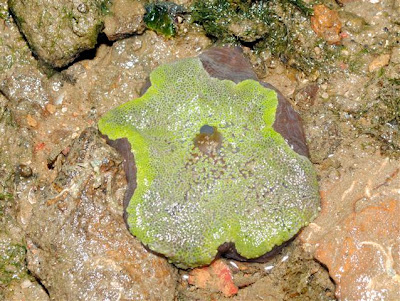It's the low tide season again and we're back at the colourful shores of Punggol. It's a taking-it-easy trip for me as I am still recovering from an injury due to a cycling accident.
The colourful sponges of both encrusting and branching forms give a glimpse of the remote and pristine northern shores that are offshore of our mainland.
Though there are still a good representation and assemblage of different species of sponges, Mei Lin and I felt that there are fewer of them now as compared to last year.
With sponges as food, there are bound to be nudibranchs! Mei Lin never fails to find these slugs! We saw two of these Beaded nudibranch (Hoplodoris nodulosa). The first one was found by Ria.
As for me, I found this pair of Rose nudibranch (Dendrodoris fumata). It's the third time I'm seeing them here. :)
Despite the usual murky waters found along the Straits of Johore, it is surprising to see how colourful and crowded the jetty leg can be during a low spring tide.
The jetty legs are full of encrusting ascidians, snails and crabs!
An organism that can surely be sighted on this shore will be this weird looking creature, the Encrusting snails (Vermetus sp.). Yes it is a snail which looks like hard casts from worms. However, these snails have a trap door or an operculum at the end of the hole to prevent predator invasion or stress from the environment.
Another creature that is distinct of Punggol shore will be the numerous pretty Burgundy anemones (Bunodosoma goanese). It was identified by Dr Daphne, sea anemone expert, during her visit here last year.
When out of water, their tentacles are tucked inwards, showing the dotted body column. The lips on the oral disk are quite prominent when submerged underwater.
Of course, who can ever miss the plentiful Black sea urchins (Temnopleurus sp.) that were found lying all over the entire shore. :)
My first sighting for this shore will be this huge Mud crab (Scylla sp.)! This is the type of crab that we consume during seafood meals!
Later on, we saw a dead version of the same species of crab. Mei Lin gamely volunteered to put her hand as a scale of how big the crab is.
The most abundant crab on this shore must be the Thunder crabs (Myomenippe hardwickii). Not too sure if it is because it is in the wee hours, these crabs seem to be stoning on the shores... haha.
Looking alike to the thunder crabs, I think this crab is the Maroon stone crab (Menippe rumphii).
As the name suggests, it has two pairs of legs that are short and bent permanently over the back. These legs are tipped with hairy pads to cling onto a leaf and used like paddles to swim slowly about.
Another crab that clings onto other substrate will be this cute little Sponge crab (Family Dromiidae) with pink tipped claws.
Marcus found this Spider crab (Schizophrys sp.) which I think is the most colourful among those that I've came across.
As the shore is rather rocky, there are quite a number of creatures found underneath the rocks and boulders. This Hoof-shield limpets (Scutus sp.) is probably Scutus unguis.
I was rather worried not finding the resident Rock stars (Asterina coronata but was relieved to see them towards the end of the exploration.
It was also heartening to see many brittle stars roaming about on the shore when the sun has not risen.
On a closer look, these brittle stars have different patterns and colours. I'm still not pro in identifying them though.
There are quite a number of Volvatella slugs (Volvatella vigourouxi) found among the seaweed. Can you see a pair of them? The smaller one is the male while the bigger one is the female.
Here are more photos of the numerous slugs found on the trip.
Last but not least, ending off this post with a medium sized Haddon's carpet anemones (Stichodactyla haddoni).
I was not as adventurous and energetic this time to look at a further stretch of shore which Ria covered. She found slugs, a seahorse among sea fans and other amazing stuffs! Do read her blog!






























No comments:
Post a Comment